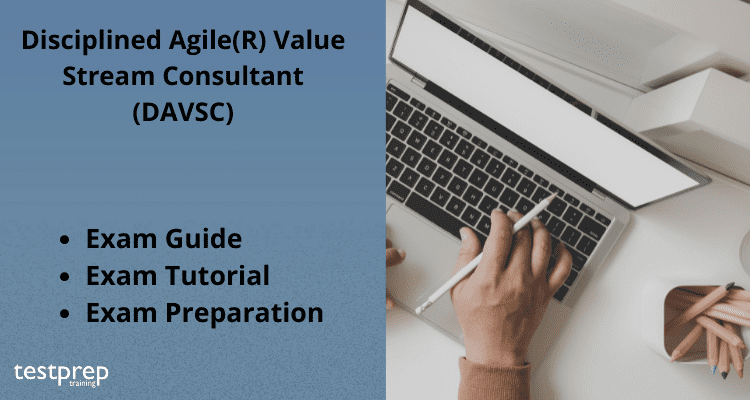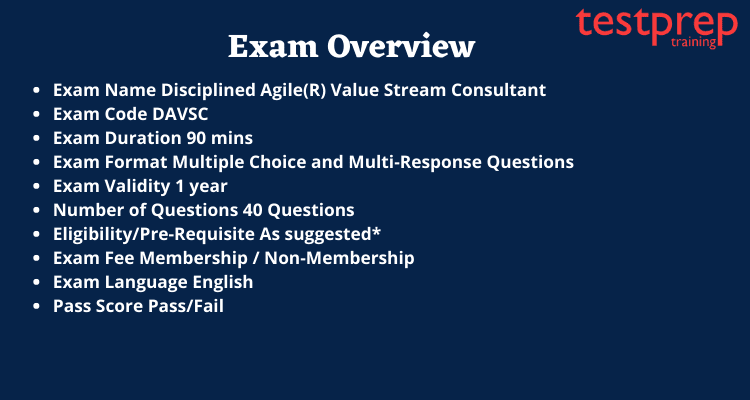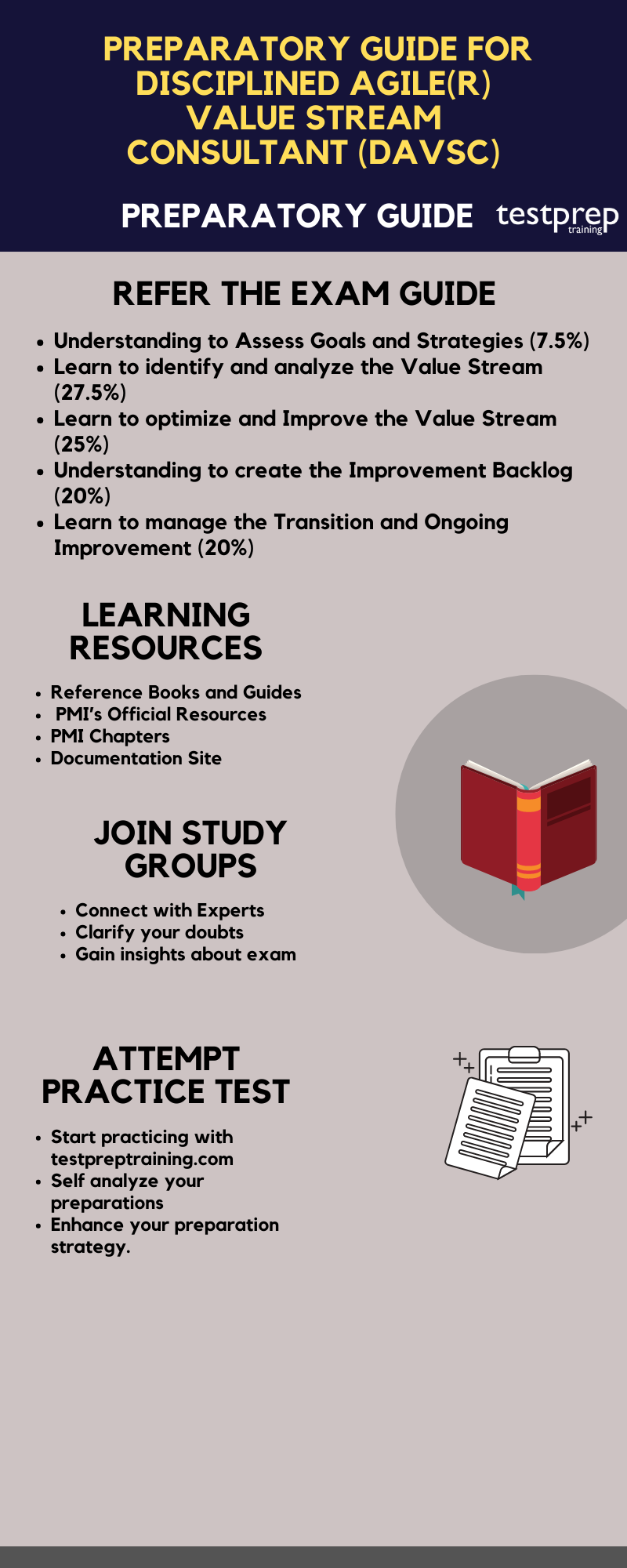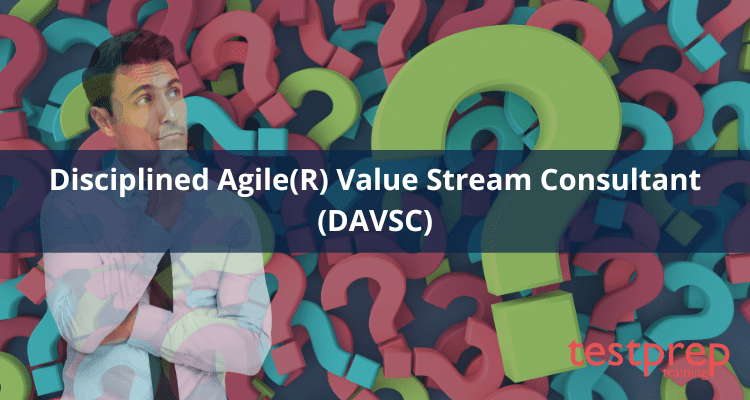Disciplined Agile(R) Value Stream Consultant (DAVSC)

The Disciplined Agile(R) Value Stream Consultant (DAVSC) test is focused on integrating principles from Lean, Flow, the Theory of Constraints, and Organizational Development into Disciplined Agile, as well as the tools for enhancing enterprise-wide value streams. The Disciplined Agile Value Stream Consultant (DAVSC) test aids in the development of skills necessary to deploy Disciplined Agile across the enterprise, moving beyond individual teams and accelerating value creation at scale.
Qualifications Required for DAVSC
For the DAVSC certification exam, candidates must:
- To successfully finish the three-day instructor-led Disciplined Agile(R) Value Stream Consultant (DAVSC) course delivered online by a PMI Authorized Training Provider (ATP).
- Three years of experience with agile methodologies are required for the DAVSC certification.
- To ensure thorough familiarity with the DA toolset, as well as the principles and methods it incorporates, candidates must meet the requirements for the Disciplined Agile Senior Scrum Master (DASSM) certification.
Exam Overview

Course Outline
Assess Goals and Strategies: 7.5%
- Describe the Clients and (internal and external) motivation and expectations
- Determine extent or scope of engagement and possible transformation
- Facilitate client discussion, share, and align approaches with stakeholders based upon findings.
Identify and Analyze the Value Stream: 27.5 %
- Identify the value stream
- Identify organizational structure and culture
- Identify motivation
- Describe the value creation structure
- Explain where agile budgeting and funding strategy activities take place in the value stream
- Map ‘as is’ end-to-end process
- Walk the floor to determine correctness of map and identify constraints and restraints
- Analyze and illustrate value stream metrics (cycle time, lead time, etc.)
- Advise stakeholders on backlog of improvements and prioritize
- Describe how an MBI is used in a Disciplined Agile workflow – including who uses it and why it is used
Optimize and Improve the Value Stream: 25%
- Demonstrate quick feedback cycles across the value stream
- Demonstrate explicit workflow so people can understand what the agreements are between the groups
- Apply a holistic view
- Use a combination of eliminate delays, quick feedback, visibility and focus on value to align people across the organization
- Explain how visual controls can be used to keep people coordinated with fewer meetings
- Identify strategies for risk issues and opportunities (internal and external)
- Describe each role and its range of influence and participation across the value stream
- Describe value stream-aligned teams and how they are aligned within an organization using the DA FLEX approach
- Identify and describe strategies, systems, processes, and tools that reduce and remove dependencies
- Explain how the use of MBIs can coordinate people and teams around the flow of work in order to improve the flow of value
Creating the improvement of the backlog: 20%
- Identify areas needed for improvement
- Create areas of improvement for backlog
- Advise stakeholders and teams (organizational enablers) who will support value stream enhancements or improvements
- Understand the relationship between culture, management, and visual controls
- Align value stream to portfolio – project to product
- Establish a continuous pipeline (customer service after implementation, continuous implementation)
Managing the transitions and ongoing improvement: 20%
- Understand the neutral zone
- Model a cadence of improvement and acknowledge success and pivot on failures
- Understand different types of starting and agree on pace of adoption
- Apply methods to create backlog to do guided continuous improvement
- Organize teams to coordinate and facilitate the transition
- Explain to stakeholders how improvements are focused around increased value
- Attend to operations, enabling and supporting value streams
- Prepare the organization to sustain new changes (validate progress and added value)
For more information, click on the Disciplined Agile(R) Value Stream Consultant (DAVSC) FAQ.
Exam Retaking Policy
After paying for the exam, candidates have 60 days to take it. When taking the exam, candidates have the option to pay to retake it if they are unsuccessful the first time. Each candidate will have a total of three first exam attempts within the 60-day eligibility period. After three unsuccessful exam attempts, there will be a 45-day eligibility waiting period before you can pay for an exam retake. Utilize the content from the course and your existing experience to prepare for the exam during this 45-day window, according to PMI.
Preparatory Guide: Disciplined Agile(R) Value Stream Consultant (DAVSC)
With the course modules and the remaining time before the final, most important exam in mind, the goal is to develop an examination schedule. Always begin by paying attention to the areas that are more exposed. It will be less difficult for you to avoid distractions while reading this study guide.

Refer to the Exam Objectives
Understanding the main objectives of the Disciplined Agile(R) Value Stream Consultant (DAVSC) test is the first step in getting ready for it. The PMI website contains a comprehensive course outline. Understanding the exam’s objectives is crucial for achieving your certification goals. Using this method, you’ll learn the skills and knowledge you need to succeed.
- Understanding to Assess Goals and Strategies (7.5%)
- Learn to identify and analyze the Value Stream (27.5%)
- Learn to optimize and Improve the Value Stream (25%)
- Understanding to create the Improvement Backlog (20%)
- Learn to manage the Transition and Ongoing Improvement (20%)
PMI’s Official Resources
On the official PMI website, you may find two essential tools for passing the Disciplined Agile(R) Value Stream Consultant (DAVSC) exam. The two sources are as follows:
PMI Chapters
The purpose of this tool is to help candidates evaluate self-study books created by trustworthy training organisations and Registered Education Providers (R.E.Ps). This medium provides key corporations and industries with high-quality material, as well as 3 million students across 82 countries.
Be a part of study groups
It is crucial to communicate with people who are preparing for the same exam. You’ll be able to comprehend the concepts better as a result. You can also ask them questions and inquire about your circumstance. Students will study the content required to pass the test through group discussions. Joining an online community like Quora that enables you to connect with people who are taking the same career path as you will be beneficial for you.
Start Practicing with Testpreptraining
Furthermore, a guy can only become faultless via practise. By practising more, you’ll become more proficient. You’ll get used to the exam environment, boost your confidence, and recognise any flaws you might have. You will understand what areas you need to improve on as well as become more acquainted to the exam environment by figuring them out. These practise tests must be real and up to date. So start here on your path to prosperity!z


